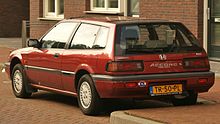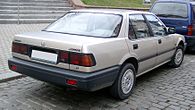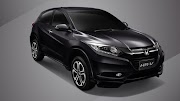Third generation (1985–1989)
| Third generation series CA1/2/3/4/5/6 | |
|---|---|

Accord DX sedan
| |
| Overview | |
| Also called | Honda Vigor (Japan) |
| Production | 1985–1989 |
| Model years | 1986–1989 |
| Assembly | Sayama, Saitama, Japan Marysville, Ohio, USA (Marysville Auto Plant) Alliston, Ontario, Canada (HCM) Petone/Nelson, New Zealand (New Zealand Motor Corporation/Honda New Zealand) Ayuthaya, Thailand (Honda Cars (Thailand) Co.) North Jakarta, Indonesia (PT. Prospect Motor) Johor Bahru, Malaysia (OASB)[16] |
| Designer | Toshi Oshika (1983) |
| Body and chassis | |
| Class | Compact car |
| Body style | 2-door coupe 3-door hatchback 3-door shooting-brake (AeroDeck) 4-door sedan |
| Powertrain | |
| Engine | 1.6L A16A1 I4, 88 hp (66 kW) 1.8L A18A I4, 100 hp (75 kW) 1.8L B18A I4, 115 hp (86 kW) 2.0L A20A/A20A1/A20A2 I4, 98–108 hp (73–81 kW) 2.0L A20A3/A20A4 I4, 110–122 hp (82–91 kW) 2.0L B20A I4, 145 hp (108 kW) 2.0L B20A2 I4, 137 hp (102 kW) 2.0L B20A8 I4, 133 hp (99 kW) |
| Transmission | 4-speed automatic 5-speed manual |
| Dimensions | |
| Wheelbase | 2,600 mm (102.4 in) |
| Length | Hatchback: 4,440 mm (174.8 in) 1985–1987 Sedan: 4,549 mm (179.1 in) 1987–1989 Sedan & Coupe: 4,564 mm (179.7 in) |
| Width | Hatchback & Coupe: 1,694 mm (66.7 in) Sedan: 1,712 mm (67.4 in) |
| Height | Hatchback & Coupe: 1,336 mm (52.6 in) Sedan: 1,356 mm (53.4 in) |
The third-generation Accord was introduced in Japan on 4 June 1985, and in Europe and North America later that year. It had a very striking exterior design styled by Toshi Oshika in 1983, that resonated well with buyers internationally. One notable feature was the hidden headlamps. Because this generation was also sold as the Honda Vigor, the Accord received the hidden headlamps. Honda's Japanese dealership channel called Honda Verno all had styling elements that helped identify products only available at Honda Verno. As a result, Japanese market Accords had a Honda Verno styling feature, but were sold at newly established Japanese dealerships Honda Clio with the all-new, luxury Honda Legend sedan, and international Accords were now visually aligned with the Prelude, the CR-X, and the new Integra.
The retractable headlamps of the third generation Accord sedan were in Japan, USA, Canada, Australia, New Zealand, KY region (Arabian countries) and on cars in Taiwan that were imported from the United States. In other countries, the Accord sedan had conventional headlamps, including in Japan from July 1987, on "Accord CA", with CA standing for "Continental Accord". Accords in all other bodies (hatchback, AeroDeck, coupe) had only retractable headlamps worldwide.
At its introduction in 1985, it won the Car of the Year Japan Award.[citation needed]
The third-generation Accord became the first Honda to employ double wishbones at both the front and rear ends. While more expensive than competitors' MacPherson strut systems, this setup provided better stability and sharper handling for the vehicle. All had front sway bars and upper models had rear sway bars as well. Brakes were either small all-wheel discs with twin-piston calipers (only available on the Japanese-market 2.0-Si model), larger all-wheel discs with single piston calipers, or a front disc/rear drum system. ABS was available as an option on the 4-wheel disc brake models, though not in North America. Base model Accords rode on 13-inch steel wheels with hubcaps with more expensive models having the option of 14-inch alloy wheels.
The Accord's available engines varied depending on its market: Japan received the A18A, A20A, B18A, B20A and A20A3 (US imported cars); Europe received the A16A1, A20A1, A20A2, A20A3, A20A4, B20A2, and B20A8; Australia and New Zealand received A20A2 and A20A4; other regions received A20A2 and/or A16A1; while United States, Canada and Taiwan (US imported cars) received the A20A1 and A20A3. On Accord 1986 model year engine block was marked as BS and BT in the United States, BS1 and BT1 in Canada, this cars had chassis code BA. Since 1987 the engine block in Indonesia was marked as NA instead of A20A2. The engine block in Thailand was marked as A.
In Japan, the introduction of a 2.0 liter engine obligated Japanese drivers to pay a higher amount of annual road tax compared to the last two previous generations, pushing the Accord into the luxury category in Japan.
The Accord's trim levels ranged from spartan to luxurious. In the Japanese home market, the Accord was available with a full power package, heated mirrors (optional), a digital instrument cluster (optional), sunroof (optional), cruise control, and climate control (which was also optional). Some North European export models also had heated front seats and head light washers. North American and Australian Accords were not available with most of these options, presumably (and in the U.S. in particular) because Honda was seen as a builder of economy cars, and not to cannibalize sales from the recently introduced[when?] Acura line.
Throughout the different markets, in addition to the sedan model the Accord was available with different bodystyles which included a three-door hatchback, a three-door shooting-brake called Accord AeroDeck, and a two-door coupe which was added in 1987 for the 1988 model year. The coupe, which was built exclusively in Honda's Marysville, Ohio factory, was "reverse exported" back to Japan where it was known as the US-coupe CA6.
Accord AeroDeck[edit]
The third-generation Accord was sold in Japan, Europe and New Zealand as a three-door hatchback with a flat roof over the rear seats, known in Europe as a shooting-brake. The bodystyle of a flat roof hatchback was also used on the third-generation Honda Civic (third generation) subcompact, the second-generation Honda City supermini and the first-generation Honda Today kei car. The Honda CR-X was the only three-door hatchback that adopted a fastback, sloping rear hatch "kammback" appearance, demonstrating a performance car appearance identified with Honda Verno products during the mid-1980s.
In North America, the Accord coupe and hatchback models were offered instead. The "AeroDeck" name was reused on the Honda Civic 5-door station wagon, sold in the UK from 1996 to 2000. In parts of Continental Europe, the Accord five-door station wagon was also called the Accord AeroDeck from 1990 until 2008, when the name of the station wagon was renamed the "Accord Tourer".[30] The AeroDeck was only available in Japan at Honda Clio dealerships as a variation of the Accord.
The cargo handling abilities of the AeroDeck were ceded to the fourth-generation Accord station wagon in 1990. The AeroDeck was unique to the Accord model line, as the AeroDeck was not available as a Honda Vigor, as the Accord and Vigor were mechanically identical. The AeroDeck returned an aerodynamic value of .34, and the 2,600 mm (102.4 in) wheelbase returned a spacious interior for both front and rear passengers, on par with a mid-size sedan. Unfortunately, the appearance was not well received in Japan, as the introduction of the Accord Coupe was more well-liked. The appearance was more popular in the United Kingdom.
The AeroDeck was equipped with a four-wheel double wishbone suspension, which gave both a comfortable ride and cornering performance. In addition, speed-sensitive power steering is included, which gives the car easy turning assistance at speeds below 40 kilometres per hour (25 mph) during operation, such as parallel parking. Note that the top model in Japan "2.0Si" is to 4w-ALB (4-wheel ABS) are standard equipment (with option to upgrade in other trim packages).
Visibility from the driver's seat and passenger seat was better due to the lower instrument panel design of the front window and a large windshield. And switches are arranged efficiently and at the time was the driving position can be fine-tuned adjustments.
Because of the shape of the vehicle and the flat roof that continued to the rear of the vehicle, opening the rear hatch had some drawbacks in low clearance environments. The lower part of the hatch was not like one used on a station wagon that went all the way down to the rear bumper, so loading cargo into the back wasn't as convenient as a conventional station wagon with a one piece hatchback. The rear hatch also wrapped into the rear roof, similar to a gull wing door so that the rear glass was in two pieces, one for the back window, and another partially on the rear roof. When open, the hatch rose above the roof at a right angle, providing additional overhead clearance when the hatch was open.
Moreover, because of the emphasis on aiding rear-seat passenger entry, a longer front door was installed, and because power windows were not installed on the lower trim packages "LX", "LX-S" and as such, the window regulator opening felt heavy.
Chassis code configurations[edit]
| CODE | ENGINE CODE | REGION(S) | |
|---|---|---|---|
| - | CA1 | A18A | Japan |
| - | CA2 | B18A | Japan |
| - | CA3 | B20A | Japan |
| JHM | CA4 | A16A1 | Europe, Turkey, Pakistan, Singapore and some other |
| JHM/1HG | BA'86 | BS/BT | USA |
| BS1/BT1 | Canada | ||
| JHM | CA5'87+ | A20A1/A20A3 | USA, Canada |
| 1HG | USA, Canada'89 | ||
| Taiwan (US import) | |||
| 2HG'87-'88 | USA'88, Canada | ||
| - | CA5'87.05+ | A20A | Japan |
| - | CA5 | A20A2 | Malaysia |
| JHM | A20A1/A20A2/A20A3'87+/A20A4/B20A2'87+/B20A8'88+ | Europe | |
| A20A2/A20A4'87+ | Australia | ||
| A20A4 | New Zealand (Aerodeck only) | ||
| A20A2 | other | ||
| 1HG | CA6'88+ | A20A1/A20A3 | USA, Canada |
| - | CA6'88.04+ | A20A3 | Japan (US import) |
| - | SE3 | A20A2'86/NA'87+ | Indonesia |
| - | AC | A | Thailand |
| - | different | A20A2/A20A4'87.10+ | New Zealand (except Aerodeck) |


















0 Comments